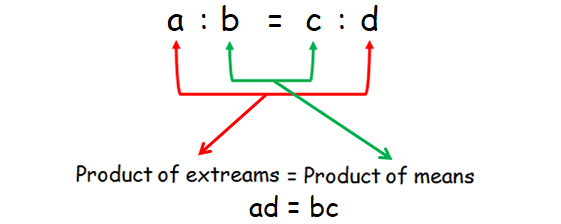PROPERTIES OF PROPORTION
Subscribe to our ▶️ YouTube channel 🔴 for the latest videos, updates, and tips.
Following are the properties of proportion :
1. Cross Product Rule
2. Invertendo Property
3. Alternendo Property
4. Componendo Property
5. Dividendo Property
6. Componendo and Dividendo Property
7. Addendo Property
8. Subtrahendo Property
Cross Product Rule
Consider the following proportion :
a : b = c : d
a and d ----> extremes
b and c ----> means
In a proportion,
product of extremes = product of means
In the proportion a : b = c : d, we have
ad = bc
This property is called cross product rule.

Three quantities a, b, c of the same kind (in same units) are said to be in continuous proportion.
If three quantities a, b, c are in continuous proportion, then the middle term b is called the mean proportional between a and c, a is the first proportional and c is the third proportional.
Since three quantities a, b, c are in continuous proportion, we can write them as
a : b = b : c
Using cross product rule, we can solve for the mean proportion b.
product of means = product of extremes
b2 = ac
Taking square root on both sides,
b = √ac
Invertendo Property
Let the two ratios a : b and c : d be in proportion.
a : b = c : d
Then their inverse ratios will also be in proportion, this property is called invertendo property.
b : a = d : c
Alternendo Property
Let the two ratios a : b and c : d be in proportion.
a : b = c : d
By interchanging the means b and c, we get two new ratios:
a : c and b : d
Now, the two ratios a : c and b : c are in proportion.
a : c = b : d
Componendo Property
Let the two ratios a : b and c : d be in proportion.
a : b = c : d
In each ratio, by adding the second term to the first term, we get
(a + b) : b and (c + d) : d
Now, the two ratios (a + b) : b and (c + d) : d are in proportion.
(a + b) : b = (c + d) : d
Dividendo Property
Let the two ratios a : b and c : d be in proportion.
a : b = c : d
In each ratio, by subtracting the second term from the first term, we get
(a - b) : b and (c - d) : d
Now, the two ratios (a - b) : b and (c - d) : d are in proportion.
(a - b) : b = (c - d) : d
Componendo and Dividendo
Let the two ratios a : b and c : d be in proportion.
a : b = c : d
In each ratio, add the second term to the first term and take the result as the first term, subtract the second term from the first term and take the result as the second term.
Then, we have
(a + b) : (a - b)
(c + d) : (c - d)
Now, the above two ratios are in proportion.
(a + b) : (a - b) = (c + d) : (c - d)
Addendo Property
Consider the following continued proportion.
a : b = c : d = e : f =..........
Add all the first terms and take the result as the first term and add all the second terms and take the result as the second term.
Then, we get
(a + c + e + ........) : (b + d + f + ........)
Now, the ratio (a + c + e + ........) : (b + d + f + ........) is equal to each ratio in the above continued proportion.
That is,
a : b = c : d = e : f =..... = (a + c + e + .....) : (b + d + f + .....)
Subtrahendo Property
Consider the following continued proportion.
a : b = c : d = e : f =..........
Subtract all the first terms (except the first term in the first ratio 'a') from the first term of the first ratio and take the result as the first term and subtract all the second terms (except the second term in the first ratio 'b') from the second term of the first ratio and take the result as the second term.
Then, we get
(a - c - e - ........) : (b - d - f - ........)
Now, the ratio (a - c - e + ........) : (b - d - f - ........) is equal to each ratio in the above continued proportion.
That is,
a : b = c : d = e : f =..... = (a - c - e - .....) : (b - d - f - .....)
Solving Problems Using Properties of Proportion
Problem 1 :
If a : b = c : d = 2.5 : 1.5, what are the values of ad : bc and a + c : b + d ?
Solution :
In the given proportion a : b and c : d, applying cross product rule, we get
ad = bc
Dividing by bc on both sides, we get
ad/bc = 1
ad/bc = 1/1
ad : bc = 1 : 1
Given : a : b = c : d = 2.5 : 1.5 ------ (1)
In the given proportion a : b and c : d, applying the property addendo, we get
a : b = c : d = (a+b) : (c+d) ------ (2)
From (1) and (2), we get
(a+b) : (c+d) = 2.5 : 1.5
(a+b) : (c+d) = (2.5x10) : (1.5x10)
(a+b) : (c+d) = 25 : 15
(a+b) : (c+d) = (25/5) : (15/5)
(a+b) : (c+d) = 5 : 3
Problem 2 :
If a : 3 = b : 4 = c : 7, then, find the value of (a+b+c) : c
Solution :
In the given proportion a : 3 = b : 4 = c : 7, applying the property addendo, we get
a : 3 = b : 4 = c : 7 = (a + b + c) : (3 + 4 + 7)
a : 3 = b : 4 = c : 7 = (a + b + c) : 14
Now, all the above four ratios are equal.
Taking the last two ratios, we get
c : 7 = (a + b + c) : 14
c / 7 = (a + b + c) / 14
14 / 7 = (a + b + c) / c
2 = (a + b + c) / c
or
(a + b + c) / c = 2/1
(a + b + c) : c = 2 : 1
Subscribe to our ▶️ YouTube channel 🔴 for the latest videos, updates, and tips.
Kindly mail your feedback to v4formath@gmail.com
We always appreciate your feedback.
About Us | Contact Us | Privacy Policy
©All rights reserved. onlinemath4all.com

Recent Articles
-
Times Table Shortcuts
Dec 30, 25 07:14 PM
Times Table Shortcuts - Concept - Examples -
10 Hard SAT Math Questions (Part - 42)
Dec 30, 25 05:52 AM
10 Hard SAT Math Questions (Part - 42) -
10 Hard SAT Math Questions (Part - 38)
Dec 29, 25 04:21 AM
10 Hard SAT Math Questions (Part - 38)

